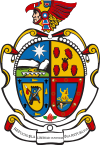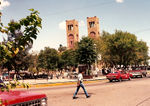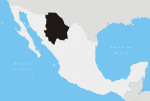Ciudad Juárez
| Ciudad Juárez Juárez |
|||
|---|---|---|---|
|
|||
| Nickname(s): Gateway of Mexico, El Paso del Norte, Juaritos | |||
 Ciudad Juárez
|
|||
| Coordinates: | |||
| Country | |||
| State | Chihuahua | ||
| Municipality | Juárez | ||
| Foundation | 1659 | ||
| Government | |||
| - Municipal president | José Reyes Ferriz ( |
||
| Area | |||
| - Total | 188 km2 (72.6 sq mi) | ||
| Elevation | 1,120 m (3,675 ft) | ||
| Population (2005) | |||
| - Total | 1,400,891 | ||
| - Density | 7,452/km2 (19,290/sq mi) | ||
| - Demonym | Juarense | ||
| Time zone | Mountain Standard Time (UTC-7) | ||
| - Summer (DST) | Mountain Daylight Time (UTC-6) | ||
| Area code(s) | +52 656 | ||
| Website | http://www.juarez.gob.mx | ||
Ciudad Juárez (Spanish pronunciation: [sjuˈðað ˈxwaɾes]), also known as Juárez and formerly known as El Paso del Norte, is a city and seat of the municipality of Juárez in the Mexican state of Chihuahua. Juárez has an estimated population of 1.5 million people.[1] The city lies on the Rio Grande (Río Bravo del Norte), across from El Paso, Texas. El Paso and Ciudad Juárez comprise one of the largest bi-national metropolitan areas in the world with a combined population of 2.4 million people.
Ciudad Juárez is one of the fastest growing cities in the world in spite of the fact that it has been called "the most violent zone in the world outside of declared war zones."[2] In 2001 the Federal Reserve Bank of Dallas published a report stating that in Ciudad Juárez “the average annual growth over the 10-year period 1990-2000 was 5.3 percent. Juárez experienced much higher population growth than the state of Chihuahua and than Mexico as a whole.”[3]
There are four international ports of entry connecting Ciudad Juarez and El Paso, Texas, including the Bridge of the Americas, Ysleta International Bridge, Paso Del Norte Bridge, and Stanton Street Bridge, which combined were responsible for 22,958,472 crossings in 2008,[4] making Ciudad Juarez a major point of entry and transportation for all of central northern Mexico. The city has a growing industrial center which is made up in large part by more than 300 maquiladoras (assembly plants) located in and around the city. According to a 2007 New York Times article, Ciudad Juárez "is now absorbing more new industrial real estate space than any other North American city."[1] In 2008, FDi Magazine designated Ciudad Juárez "The City of the Future".[5] However, the city is also the site of widespread poverty and violence, including an infamous series of unsolved murders of female factory workers.[6] The violence generated by the narco-insurgency translated into some 6,000 killings in 2008. More than 1,600 of them occurred in Juárez, three times more than the most murderous city in the United States.[7] And that number of killings increased to 2,600 in 2009.[8] In response, business groups in Juárez have called for UN intervention.[9][10]
Contents |
History
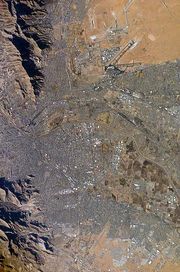
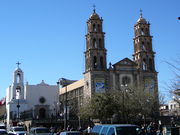
Ciudad Juárez was founded as El Paso del Norte ("North Pass") in 1659 by Spanish explorers seeking a route through the southern Rocky Mountains. The Mission de Nuestra Señora de Guadalupe was the first permanent Spanish development in the area; Native America population was already located there. The Jesuit friars established a community that grew in importance as commerce between Santa Fe and Chihuahua passed through it. The wood for the bridge across the Rio Grande first came from Santa Fe, New Mexico in the 1700s. The original population of suma, jumano and immigrants brought by the Spanish as slaves from Central New Spain grew around the mission. In 1648 during the Pueblo Revolt, some members of the Tigua branch of the Pueblo became refugees from the conflict and a Mission was established for them in Ysleta del Paso del Norte. The population grew until around 1750, when the Apache attacked the other native towns around the missions. The 1848 Treaty of Guadalupe Hidalgo established the Rio Grande as the border between Mexico and the United States, separating the settlements on the north bank of the river from the rest of the town.
Such settlements were not adjoined to the town at that time, and as the military set up its buildings, the town grew around it. This would later become El Paso, Texas. From that time until around 1930 populations on both sides of the border could move freely across it. Ciudad Juárez and El Paso are one of the 14 pairs of Cross-border town naming along the U.S.–Mexico border. During the French intervention in Mexico (1862–1867), El Paso del Norte served as a temporary stop for Benito Juárez's republican forces until he established his government-in-exile in Chihuahua. In 1888, El Paso del Norte was renamed in honor of Juárez.
Juárez has grown substantially in recent decades due to a large influx of people moving into the city in search of jobs with the maquiladoras. Now more technological firms have been attracted into the city such as the Delphi Corporation Technical Center, the largest in the Western Hemisphere, which employs more than 2,000 engineers. Large slum housing communities called colonias have become extensive.
Juárez has gained further notoriety because of violence [11] and as a major center of narcotics trafficking linked to the powerful Juárez Cartel, and for more than 1000 unsolved murders of young women since 1993. Unfortunately, because of widely alleged police complicity (and perhaps even participation on the part of police and government officials and local elites), the serial murders continue and most of them remain unsolved despite the years that have gone by, though the number of homicides has fallen slightly since 2004 despite the increase of population. As a result of the murders, Juárez (along with the capital of the state, Chihuahua, Chih.) has become a center for protest against sexual violence throughout Mexico.[12] Meanwhile, many continue working to maintain a positive image of Ciudad Juárez. Songs 'Juarez' by the music artist Tori Amos and 'Invalid Litter Dept.' by At the Drive-In refer to Ciudad Juárez and the murders of women therein. A giant Mexican flag, bandera monumental, was erected in Chamizal Park on June 26, 1997.
Climate
Ciudad Juárez has an arid climate because it is located in the Chihuahuan desert. Seasons are extremely well defined, hot summers, cold winters and cool springs and fall. Summer average high is 34 °C (93 °F) with lows of 22 °C (72 °F), on the other hand winter high is 14 °C (57 °F) with lows of 1 °C (34 °F). Because of the high altitude Ciudad Juárez is cooler than other desert cities in Mexico. Rainfall is very scarce but it is more prominent in the summer months. Snowfall is not a rare event—it normally snows once or twice every winter. The record high is 46 °C (115 °F) and the record low is −22 °C (−8 °F).
| Ciudad Juárez | ||||||||||||||||||||||||||||||||||||||||||||||||||||||||||||
|---|---|---|---|---|---|---|---|---|---|---|---|---|---|---|---|---|---|---|---|---|---|---|---|---|---|---|---|---|---|---|---|---|---|---|---|---|---|---|---|---|---|---|---|---|---|---|---|---|---|---|---|---|---|---|---|---|---|---|---|---|
| Climate chart () | ||||||||||||||||||||||||||||||||||||||||||||||||||||||||||||
|
||||||||||||||||||||||||||||||||||||||||||||||||||||||||||||
|
||||||||||||||||||||||||||||||||||||||||||||||||||||||||||||
Demographics
The average annual growth in population over a 10-year period [1990–2000] was 5.3%.[13] According to the 2005 population census, the city had 1,301,452 inhabitants, while the municipality had 1,313,338 inhabitants. According to the 2009 census Ciudad Juárez is now larger than Tijuana, BC.[14] During the last decades the city has received migrants from Mexico's interior, some figures state that 32% of the city's population originate outside the state of Chihuahua, mainly from the states of Durango (9.9%), Coahuila (6.3%), Veracruz (3.7%) and Zacatecas (3.5%), as well as from Mexico City (1.7%).[13] Though most new comers are Mexican, some also are immigrants from Central American countries, such as Guatemala, Honduras and Nicaragua.
However, a March 2009 Wall Street Journal article noted there has been a mass exodus of people who could afford to leave the city. The article quoted a city planning department estimate of over 116,000 abandoned homes, which could roughly be the equivalent of 400,000 people who have left the city due to the violence.[15] An article in The Guardian in September 2010 says of Ciudad Juarez - "About 10,670 businesses - 40% of the total - have shut. A study by the city's university found that 116,000 houses have been abandoned and 230,000 people have left."[16]
Cityscape
Neighborhoods of Ciudad Juárez include:
- Campestre
- Rivera del Bravo
- Anapra
Government
The city is governed by a municipal president and an eighteen seat council. The current president is José Reyes Ferriz, an affiliate of the Institutional Revolutionary Party (PRI). Three national parties are represented on the council: the PRI, the National Action Party and the New Alliance Party.[17] On February 6, 2010 the governor of Chihuahua, José Reyes Baeza announced that he wished to move Chihuahua's state seat of government to the city, as a temporary measure to reduce crime.[18]
Crime and safety
Criminal activity in the domestic metropolitan area of Juárez has increased dramatically since the rise of maquiladoras and especially following the establishment of the North American Free Trade Agreement (NAFTA) in 1994, two factors which attracted both international commerce and many younger women and their families to Juárez in search of better economic opportunities. Violence towards women in the municipality has increased dramatically in the past twenty years;[19] since the early nineties there have been approximately 600 femicides[20] and at least 3000 missing women.[19] Escalating turf wars between the rival Juárez and Sinaloa Cartels have led to increasingly brutal violence in the city since the mid-2000s.
The Juárez police department had a force of approximately 800 officers in September 2008, following the removal of a third of its human resources for various reasons. Recruitment goals set by the department called for the force to more than double.[21] Juárez Citizens Command threatened to take action to attempt to put a stop to all the perpetrators of violence while government officials expressed concern that such vigilantism would contribute to further instability and violence.[22] In response to the increasing violence in the city the military and Federal Police's presence had been increased almost twofold. As of March 2009 at least 4500 soldiers and federal police were in the city attempting to curtail mostly drug cartel related violence.[23] By August 2009 there were more than 7500 federal troops augmented by an expanded and highly restaffed municipal force.[24] In the year leading up to August 2009 Juárez's murder rate was the highest reported in the world, exceeding the holders of the second and third highest rates, Caracas and New Orleans respectively, by more than 25%. The rate of 130 murders per 100,000 inhabitants is the same as Caracas' 2008 statistic for same period.[25] Journalist Charles Bowden, in an August 2008 GQ article, wrote that multiple factors, including drug violence, government corruption and poverty have led to a dispirited and disorderly atmosphere that now permeates the city.[11][26]
Criminal hijacking of electronic media
PBS Newshour, Thursday, July 29, 2010, reports one Juarense social worker's analysis: young boys in Juarez are offered cell phones and money to monitor their own neighborhood street for the appearance of vehicles, and to report vehicular activity on a continuous basis. The boys are told to watch for vehicles of some given description, as detailed by the criminals. This tactic has allowed criminals to evade law enforcement efforts much more easily and flexibly.[27]
A Mexican journalist, Angela Kocherga, reports that one Juarez channel was blackmailed into broadcasting a tape from a drug cartel in exchange for releasing its reporter from kidnapping.[27]
Drug cartel violence
The body count in Mexico stood at 5,400 slayings in 2008, more than double the 2,477 reported in 2007, officials said, with over 1400 in Ciudad Juárez alone.[28][29] The population of Ciudad Juárez has had to change their daily routine and many try to stay home in the evening hours. Public life is almost paralyzed out of fear of being kidnapped or hit by a stray bullet. On February 20, 2009, the U.S. State Department announced in an updated travel alert that "Mexican authorities report that more than 1,800 people have been killed in the city since January 2008." [30] On 12 March 2009, police found "at least seven" partially buried bodies in the outskirts of the city, close to the US-Mexican border. Five severed heads were discovered in ice boxes, along with notes to rivals in the drug wars. Beheadings, attacks on police, and shootings are common in some regions.[31]
In September 2009, eighteen patients at a drug rehabilitation clinic called El Aliviane were massacred in a turf battle; the victims were lined up in a corridor and gunned down.[32] The authorities had no immediate suspects or information on the victims. Plagued by corruption and the assassination of many of its officers, the government is struggling to maintain Ciudad Juárez's police force, while other officers have quit the force out of fear of being targeted.[33] In late 2008, one murder victim was found near a school hanging from a fence with a pig's mask on his face, and another one was found beheaded hanging from a bridge in one of the city's busier streets.[34]
Female sexual homicides

Over the past 10 years Juárez has seen over 400 women fall victims to sexual homicides, their bodies often dumped in ditches or vacant lots.[6] In addition, grassroots organizations in the region report that 400 remain missing. Despite pressure to catch the killers and a roundup of some suspects, few believe the true culprits have been found. A 2007 book called The Daughters of Juárez, by Teresa Rodriguez,[35] implicates high-level police and prominent Juárez citizens in the crimes. This topic is also discussed in the 2006 book "The Harvest of Women" by journalist Diana Washington Valdez,[36] and in the novel 2666 by Roberto Bolaño, in which Ciudad Juárez is fictionalized as "Santa Teresa", a border city in Sonora.
Economy
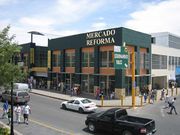
The El Paso Regional Economic Development Corporation indicated that Ciudad Juárez is the metropolis absorbing “more new industrial real estate space than any other North American city.”[37] The Financial Times Group through its publication The Foreign Direct Investment Magazine ranked Ciudad Juárez as the “City of the Future” for 2007–2008.[38] The Ciudad Juárez-El Paso area is a major manufacturing center. ADC Telecommunications, Electrolux, Bosch, Foxconn, Flextronics, Lexmark, Delphi, Visteon, Johnson Controls, Lear, Boeing, Cardinal Health, Yazaki, Sumitomo, and Siemens are some of the foreign companies that have chosen Ciudad Juárez for their business operation.[39] The Mexican state of Chihuahua is frequently among the top five states in Mexico with the most foreign investment.[40]
Many foreign retail, banking, and fast-food entities have locations within Juarez, with examples including Sears, Starbucks, Wendy's, Denny's, McDonald's, Scotiabank, and HSBC.
Transportation
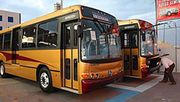
The city is served by Abraham Gonzalez International Airport, with flights to several Mexican cities. Nearby El Paso Airport handles flights to cities within the United States.
Education
According to the latest estimates, literacy rate in the city is in line with the national average in the country: 97.3% of people above 15 years old are able to read and write.[13] Juárez has three public and two private universities. The Instituto Tecnológico de Ciudad Juárez (ITCJ), founded in 1964, became the first public institution of higher education in the city. The Autonomous University of Ciudad Juárez (UACJ), founded in 1968, is the largest university in the city and has been ranked among the best universities in the country. It has several locations inside of the city including the Faculty of Biomedicine, the Social Sciences Center, the Arts and Engineering Center with spaces for Fine Arts and Sports. These latter services are considered among the best because they recluse nearly 30,000 participants in sports such as swimming, racquetball, basketball and gymnastics, and arts such as Classical Ballet, Drama, Modern Dance, Hawaiian and Polynesian Dances, Folk dance, Music and Flamenco. The Faculty of Political and Social Sciences of the Autonomous University of Chihuahua (Universidad Autónoma de Chihuahua, UACH) which has delivered 70% of the city's media and news crew, is located in the city. The local campuses of the Monterrey Institute of Technology and Higher Education (ITESM) and the Autonomous University of Durango (UAD) are private universities. The Monterrey Institute of Technology opened its campus in 1983 and it is preferred among the upper and middle classes of the city. It is ranked as "third best" among other campuses of the institution, after the Garza Sada campus in Monterrey and the Santa Fe campus in Mexico City.
Overall, the city offers a wide range of schools for every type of income and need. The city is widely recognized for its excellence in education, especially the one offered by the private sector. The main institutions in Ciudad Juárez are the Instituto Latinoamericano, a Catholic school directed from Spain, one of the colleges managed by the company founded by Spanish mystic Teresa de Avila, by direct order of the Pope to revert the effects of Protestantism in Spain; The Colegio Iberoamericano, The Middle School and High School of the ITESM, the Teresa de Avila, the Instituto Mexico. Despite this, many people choose to study in the neighbor city of El Paso, some for convenience.
Media
Newspapers
Juárez has five local newspapers: El Diario, El Norte, El Mexicano, El PM and Hoy.
Broadcasters
There are 16 over the air TV channel signals in the city: [2]
| Channel | Name | Affiliate | Country | Language | Local | National |
|---|---|---|---|---|---|---|
| 2 | Tu Canal | XHJUB | Spanish | |||
| 4 | CBS | KDBC | English | |||
| 5 | Canal 5 | XEJTV | Spanish | |||
| 7 | ABC | KVIA | English | |||
| 9 | NBC | KTSM | English | |||
| 11 | Azteca 13 | XHCJE | Spanish | |||
| 13 | PBS | KCOS | English | |||
| 14 | Fox | KFOX-TV | English | |||
| 20 | Azteca 7 | XHCJH | Spanish | |||
| 26 | Univision | KINT-TV | Spanish | |||
| 32 | Canal de las Estrellas | XEW-TV | Spanish | |||
| 40 | Multimedios | K40FW | Spanish | |||
| 44 | Canal 44 | XHIJ | Spanish | |||
| 48 | Telemundo | KTDO | Spanish | |||
| 56 | Canal 5 | XHGC | Spanish | |||
| 65 | TeleFutura | KTFN | Spanish |
There are three paid television signals available and 24 radio station signals in AM and 21 in FM.
Culture
Sport
As in most of Mexico, soccer is the most popular sport in Juárez. The local soccer team is Indios de Ciudad Juárez, which entered the Mexican First Division for the first time in 2008. Baseball, basketball, tennis, and American football are also popular, most of which are played at the high schools and university level. The Indios rent the stadium Estadio Olímpico Benito Juárez. Juárez has 2 large stadiums: Estadio Olímpico Benito Juárez and Estadio 20 de Noviembre, and smaller ones for baseball and different activities. Mountain biking is also popular, with the Chupacabras 100 km race held annually in Juárez.
Very near the Cordova International Bridge is a large combination bmx and skatepark, Parque Extremo. This park features a 20,000-square-foot (1,900 m2) concrete area with multiple ramps, rails, boxes, etc, and a 7,000-square-foot (650 m2) dirt area with ramps and tracks for bmx riding. It is much larger than the skate parks in nearby cities El Paso, Texas, and Las Cruces, New Mexico.
Ciudad Juárez served as host to the CONCACAF Women's Olympic Qualifying Tournament in 2008.
In film and other media
- Brokeback Mountain (2005) shows Jake Gyllenhaal's character Jack Twist going to Mexico to see a male prostitute. The sign on the road reads "Juarez".
- The Day After Tomorrow (2004) shows American people crossing the Rio Grande to Mexico (Juarez).
- Two novels by Chilean-born author Roberto Bolaño, The Savage Detectives and 2666, take place in Juárez, named "Santa Teresa" in the novels.
- The Virgin of Juarez (2006)
- Bordertown (2007) (The film was not actually filmed in Juárez).
- Juárez is where Marilyn Monroe divorced her third husband, Arthur Miller.
- The At the Drive-In music video for "Invalid Litter Dept." features articles and captions about the hundreds of unsolved homicides and rapes in Juárez.
- Cormac McCarthy's novel Cities of the Plain.
- The final portion of the video game Call of Juarez takes place in the desert outside of the city sometime between the American Old West era of 1865 through 1890.
- The local soccer team appeared for the first time in the videogame FIFA 09.
- The video game H.A.W.X features Juárez prominently in its first level.
- American film actor Steve McQueen died in a Juarez hospital after undergoing treatment for cancer.
Songs about Ciudad Juarez
- "Juarez" performed by Better Than Ezra
- "Juarez es el #1" performed by Juan Gabriel
- "Arriba Juarez" performed by Juan Gabriel
- "Ciudad Juarez" performed by Maria Barracuda
- "Ciudad de Bajas Pasiones" performed by Enrique Bunbury
- "Just Like Tom Thumb's Blues" performed by Bob Dylan
- "Juarez" performed by Tori Amos
- "When Sinatra Played Juarez" performed by Tom Russell
- "Hands on the Radio" performed by Chris Garneau
- "Invalid Litter Dept." performed by At the Drive-in
- "Ciudad Juárez" by Peter Loveday
- "En Juarez" by Diana Gameros
Places of interest
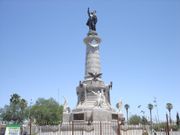
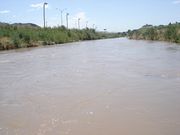
- Antigua Presidencia Municipal: (Old City Hall) Built in the 19th century, using volcanic materials and adobe, with originally fine woods. Site to many historic events.
- Mission de Guadalupe: The oldest standing building in Juárez, from the 17th century. Continuously used by the Catholic Church.
- Auditorio Civico Benito Juárez: The local theater for the arts.
- Auditorio Municipal: The new state of the art theater built behind the UACJ Med School.
- Zona Pronaf: Bars, museums, shops, restaurants, entertainment. In the Zona Pronaf, one can find bars such as La Mulata, Cafe Dali, Don Quintin, San Martin, The News, Ole Bar Chamucos, among others.
- Estadio Olímpico Benito Juárez: Home of the local soccer team Los Indios (The Indians).
- Avenida Juárez: Bars and shops.
- Parque Chamizal: Green area of the city, that consist of a park of over 40 acres (16 ha) with jogging trails, swings and recreational areas, which was once shared by El Paso and Juárez, was given back to Mexico by J.F.K in the early 1960s.
- Museo del Concorde: A place to see original parts of the airliner.
- Centro Cívico Paso del Norte (Opened on December 2006 and has been home of the Festival Internacional Chihuahua since).
- Misiones, Galerias Tec, Plaza Juárez and Rio Grande shopping malls.
- Parque Central: (Central Park) A family-oriented recreational area located 10 miles (20 km) south of the US-Mexico border.
- Parque Xtremo: The largest extreme park in Latin America.
- Cibeles: Convention Center
Notable natives and residents
- Juan Acevedo, professional baseball player
- Miguel Aceves Mejía, singer and actor
- Elizabeth Alvarez, actress
- Norma Andrade, a founding member of Nuestras Hijas de Regreso a Casa A.C.
- Antonio Attolini Lack, architect
- Liliana Domínguez, fashion model
- Lince Dorado, wrestler
- Abelardo Escobar Prieto, politician
- Fishman, wrestler
- Julio Daniel Frías, soccer player
- Gory Guerrero, wrestler
- Vanessa Guzmán, Nuestra Belleza Mexico 1996 and actress
- Juan Gabriel, singer
- Johnny "J", rapper
- Paco Lala's, television host
- Francisco Martínez, basketball player
- Karla Martínez, co-host of Despierta America
- Lilia Merodio Reza, politician
- Guadalupe Miranda, former mayor
- Luis Montes, soccer player
- Kitten Natividad, former adult film actress
- Ivonne Soto, fashion model
- German Valdes, actor
- Manuel "El Loco" Valdes, comedian
- Ramon Valdes, actor
- Tito Larriva, musician
References
- ↑ 1.0 1.1 Chamberlain, Lisa (March 28, 2007.). "2 Cities and 4 Bridges Where Commerce Flows". The New York Times. http://www.nytimes.com/2007/03/28/realestate/commercial/28juarez.html?_r=1&scp=1&sq=Where+commerce+flows&st=nyt. Retrieved March 5, 2009..
- ↑ http://www.chron.com/disp/story.mpl/breaking/6679334.html
- ↑ http://www.dallasfed.org/research/busfront/bus0102.html
- ↑ http://www.elpasotexas.gov/econdev/_documents/Community%20Profile%202008.pdf
- ↑ GDI Solutions
- ↑ 6.0 6.1 http://www.mujeresdejuarez.org
- ↑ Neighboring El Paso, Texas, with a population of 600,000, reported 10 homicides in 2009.
- ↑ "usatoday/2010-07-02". http://www.usatoday.com/news/world/2010-07-02-mexico-drug-gang-arrest_N.htm. Retrieved 2010-07-02.
- ↑ MSNBC "Mexican business groups call for U.N. troops"
- ↑ "Ciudad Juárez, Mexico: The world's most dangerous place?"
- ↑ 11.0 11.1 "Human heads sent to Mexico police", BBC News, October 21, 2008. Accessed March 5, 2009.
- ↑ Wright, Melissa. "Paradoxes, Protests, and the Mujeres de Negro of Northern Mexico." Gender, Place, and Culture, 12.3 (2005): 177–192.
- ↑ 13.0 13.1 13.2 Coronado, Roberto; Lucinda Vargas (2001). "Economic Update on El Paso del Norte". Business Frontier (2). http://www.dallasfed.org/research/busfront/bus0102.pdf. Retrieved 2008-09-15.
- ↑ II Conteo de población y vivienda 2005. Principales resultados por localidad, 2005. Chihuahua, Instituto Nacional de Estadística Geografía e Informática, 2000.
- ↑ Wars Gut Juárez, a Onetime Boom Town, Wall Street Journal, March 20, 2010. Accessed March 22, 2010.
- ↑ Mexican Drug War: The New Killing Fields, The Guardian, September 3, 2010. Accessed September 4, 2010.
- ↑ "Index of councilors" (in Spanish). Gobierno Municipal de Juárez. http://www.juarez.gob.mx/cabildo/hacienda.php. Retrieved 22 November 2009.
- ↑ "Trasladan Poderes de Chihuahua a Juárez" (in Spanish). Chihuahua, Chihuahua: El Universal. http://www.eluniversal.com.mx/notas/656753.html. Retrieved 10 February 2010.
- ↑ 19.0 19.1 Sarriya, Nidya (August 3, 2009). Femicides of Juárez: Violence Against Women in Mexico. Council on Hemispheric Affairs. http://www.commondreams.org/view/2009/08/03-8. Retrieved 28 November 2009.
- ↑ Althaus, Dudley (January 25, 2009). "Ciudad Juárez violence surges forth unabated". Ciudad Juárez: Express-News. http://www.mysanantonio.com/news/Ciudad_Juarez_violence_surges_forth_unabated.html. Retrieved 28 November 2009.
- ↑ Balderrama, Monica (September 10, 2008). "Juárez Police Department To Dismiss Third Of Force". KFOXTV.com. http://www.kfoxtv.com/news/17382955/detail.html. Retrieved 28 November 2009.
- ↑ Borunda, Daniel. "Vigilante group sets deadline for Juárez" (in January 22, 2009). El Paso Times. http://www.elpasotimes.com/ci_11522345?source=most_viewed. Retrieved 28 November 2009.
- ↑ Malone, Andrew. Thousands of Mexican soldiers pour into the country's most violent city in crackdown on drug gangs, Daily Mail, March 4, 2009. Accessed March 5, 2009.
- ↑ "Mayor of violence-torn Juarez: 'We're at turning point'". cnn.com/world (Cable News Network). August 31, 2009. http://www.cnn.com/2009/WORLD/americas/08/31/mexico.juarez.mayor/index.html. Retrieved 28 November 2009.
- ↑ "Mexican city world's murder capital". Press TV. August 27, 2009. http://www.presstv.ir/detail.aspx?id=104593§ionid=351020705. Retrieved 28 November 2009.
- ↑ Bowden, Chris (July 2008). "Mexico's Red Days". GQ (GQ.com, Conde Nast Digital): 1–6. http://www.gq.com/news-politics/big-issues/200807/juarez-mexico-border-murder-drug-war?currentPage=1. Retrieved November 27, 2009. p.2, p.3, p.4, p.5, p.6
- ↑ 27.0 27.1 PBS Newshour, Thursday, July 29, 2010
- ↑ "Body count starts anew in Mexico after record 2008 toll - CNN.com". CNN. January 6, 2009. http://edition.cnn.com/2009/WORLD/americas/01/06/mexico.violence/index.html. Retrieved April 30, 2010.
- ↑ http://www.laht.com/article.asp?ArticleId=322059&CategoryId=14091
- ↑ "Travel Alert". U.S. Department of State. 2009-02-20. http://travel.state.gov/travel/cis_pa_tw/pa/pa_3028.html. Retrieved 2009-02-23.
- ↑ "Bodies exhumed near Mexican city". BBC News (London). 2009-03-15. http://news.bbc.co.uk/1/hi/world/americas/7944427.stm. Retrieved 2009-03-15.
- ↑ Ellingwood, Ken (2009-09-04). "Juárez massacre chillingly routine". Los Angeles Times: pp. A1, A34. http://www.latimes.com/news/nationworld/world/la-fg-mexico-rehab-attack4-2009sep04,0,5425770.story. Retrieved 2009-09-06.
- ↑ http://news.yahoo.com/s/ap/20090903/ap_on_re_la_am_ca/lt_drug_war_mexico
- ↑ http://www.diario.com.mx/nota.php?notaid=89fb7fc61f65ba9b3163a1172bb90852
- ↑ http://www.amazon.com/Daughters-Juárez-Serial-Murder-Border/dp/0743292030
- ↑ http://www.amazon.com/Killing-Fields-Harvest-Women/dp/0615140084/ref=sr_1_2?ie=UTF8&s=books&qid=1230485886&sr=8-2
- ↑ 2 Cities and 4 Bridges Where Commerce Flows, The New York Times, March 28, 2007.[1]
- ↑ http://www.fdimagazine.com/news/fullstory.php/aid/1974/North_American_Cities_of_the_Future_2007_08.html
- ↑ http://www.industrytoday.com/article_view.asp?ArticleID=F289
- ↑ Mexico's Maquila Online Directory 2008, Fifth edition, page 7, Servicio Internacional de Información.
External links
- Official webpage of Juárez
- (Spanish) Secretariat of Industrial Development of Chihuahua State Government
- 2003 NPR article about the murders of Juárez women
- Border Stories video on a threatened Juarez journalist
- NY Times report on the nuclear accident
- Ciudad Juárez
|
|||||||||||||||||
